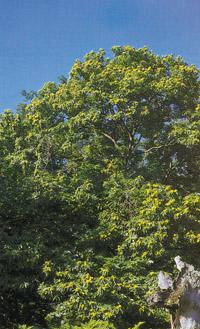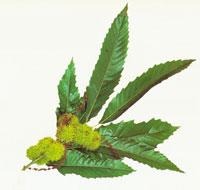Japanese chestnuts in Euskal Herria
Chestnut trees

(…) Looking at the naked escarpments and the sober places of today, it is essential to feel a point of sadness when thinking about those beautiful chestnut forests of the Basque Country of yesteryear.
(…) In places where there were once beautiful chestnut forests, there are only naked escarpments and torn landscapes.
However, there is the magnificent section of Japanese chestnut from Zudaire, as an example of what can be done if you want….
Origin
Japanese chestnut is natural in Japan and we will find it on the mountain and on the plain. Chestnut also occurs spontaneously in Korea and eastern China. The tree that grows in almost all Japanese provinces has several varieties. Moved to the United States around 1876, due to its resistance to Endothia parasitica, it was well accepted. Currently there are several well adapted varieties.
According to Camus, until 1907-1908 the Japanese chestnut did not enter France. The first plantations were carried out in Aubenas, Lindois and Vialler, subsequently extending to other territories due to their resistance to ink disease.
Repatriation of the Basque Chestnut
The Japanese chestnut that was introduced in the Basque Country, and especially in the North Basque Country, around 1909, has had a great diffusion, following the success of the first plantations of Sara and Zudaire. This is the short history of sweet chestnuts we eat in autumn:
In 1907 there were two Basque missionaries in Japan, Father Chabagno and Father Lizarraga. Father Urbain Faurie (from Loira-Garai) returned to Yokohama after a journey of collecting herbs on the Korean island of Quelpaert. During the dinner there was talk of the failure of previous trials for chestnut plantation in France. Father Faurie explained to the two Basque missionaries how to solve the problem. According to him, the key was in the excess germination activity of the chestnuts and to delay it, he recommended that they keep the chestnuts submerged for two months in the mud.
As his father was an expert in botany Faurie, Chabagno and Lizarraga decided to follow this advice. Thus, when the time came for the meeting, chestnuts were bought at a property near the village of Kawagoe (west of Tokyo). The chestnuts collected were not identified by type, but at the request of both missionaries the producer made a first selection. The missionaries then examined one by one all the chestnuts and discarded the faulty ones. Then each priest correctly prepared the clay and put all the chestnuts in well-aligned layers. After two
months of rest, the chestnuts were removed from the barros, washed well with water and put in boxes full of sand from the river, ready for the trip.

Father Chabagno sent chestnuts to his father, a peasant from Aldude, Baja Navarra, in early 1908. The chestnuts were divided into three parts: one was eaten and two were planted. A third was cultivated by his father, following the usual procedures and the other third was cultivated by his brother, following the advice of a professor of agriculture of Pau. All chestnuts germinated well, as the difference between scientific or conventional farming methods was not great. A neighbor of Aldude became interested in these trees and created a seedbed that would open the chestnut on both sides of the boundaries.
At the same time, Father Lizarraga sent Mr. Broussain a new range of chestnuts to the then judge of Hazparn. Auzapeza distributed chestnuts among several people and the result was a good number of trees in Hazparn.
Months later Father Lizarraga sent more chestnuts, but until March 1912 they did not reach Zuraide. Fortunately the chestnuts did not deteriorate along the way. The boxes had 4,000 chestnuts. The emission cost 1,000 pounds, a significant amount at the time. Most of them were planted in Zudaire itself and germination was perfect. Three years later, a hundred young trees moved to Sara and there they also grew well.
The fruits of these first trees opened year after year the chestnut in the corners of Euskal Herria. And not a single type of chestnut. If the initial chestnuts were already mixtures of different Japanese species, it gave different varieties in Euskal Herria.
Buletina
Bidali zure helbide elektronikoa eta jaso asteroko buletina zure sarrera-ontzian











